you are here: mainpage > timeline
![]()
![]()
![]()
![]()
![]()
you are here: mainpage > timeline
|
The Industrial Era 1963 - 1964 Important events: the first computergame is designed, Moore's law is defined, ASCII becomes a standard, the first general purpose computer language. |
pre history | antiquity |
pre industrial era | industrial
era
1947
- 1950 - 1952 - 1955
- 1958 - 1961 - 1963
- 1965 - 1969 - 1970
- 1972 - 1974 - 1976
1978 - 1980 - 1981 - 1982
- 1984 - 1986 -
1989 - 1991 - 1993 - 1994
- 1996 - 2000 - 2002
| Related Articles |
| Related Resources |
|
pre history |
![]() In this year ASCII
is introduced: American Standard Code for Information Interchange. This code
is developed by both the USA government and the computer industry. It is Bob
Bemer who is the chief designer for the ASCII code.
In this year ASCII
is introduced: American Standard Code for Information Interchange. This code
is developed by both the USA government and the computer industry. It is Bob
Bemer who is the chief designer for the ASCII code.
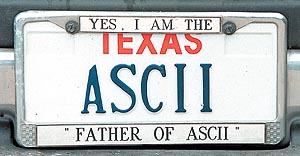
The ASCII code will be the standard character coding for years to be.
The importance of the universal code is that hitherto every computer manufacturer
had his own coding. So only via a translation table computers could exchange
data. By using the ASCII code no such tables of programs were needed anymore
and computers of all brands could exchange their data. This was a first in standardization.
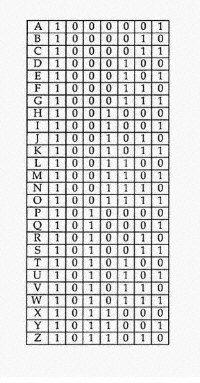
The ASCII alphabet
![]() The audio
compact cassette is invented by Philips a consumer
electronic manufacturer in the Netherlands. The compact cassette is the spin
off from a product made by Philips for a dictaphone where engineers have put
a tape into a cassette.
The audio
compact cassette is invented by Philips a consumer
electronic manufacturer in the Netherlands. The compact cassette is the spin
off from a product made by Philips for a dictaphone where engineers have put
a tape into a cassette.

This tape will become the storage medium for many home computers to come in the next two decades.
![]() The first graphic consoles DAC-1
by General Motors and Sketchpad by MIT Lincoln laboratories are developed. Sketchpad
uses the first lightpen developed by Ivan Sutherland.
The first graphic consoles DAC-1
by General Motors and Sketchpad by MIT Lincoln laboratories are developed. Sketchpad
uses the first lightpen developed by Ivan Sutherland.
![]() Douglas Engelbert invents the
mouse device at the Stanford Research Institute.
Douglas Engelbert invents the
mouse device at the Stanford Research Institute.
![]() CDC
(Control Data Computer) develops one of the first commercial SUPER COMPUTERS:
CDC 6600 and STAR100 (later rebaptized in CYBER).
This computer has ten peripheral processors known as a pre
processing unit. This unit sends the data to a central processor: CPU. This
processor runs at 3.000.000 instructions per second. (3 MIPS)
CDC
(Control Data Computer) develops one of the first commercial SUPER COMPUTERS:
CDC 6600 and STAR100 (later rebaptized in CYBER).
This computer has ten peripheral processors known as a pre
processing unit. This unit sends the data to a central processor: CPU. This
processor runs at 3.000.000 instructions per second. (3 MIPS)

![]() Intel's
chairman Gordon Moore suggests that integrated
circuits would double in complexity every year while prices will stay the same.
This suggestion will be known as Moore's Law. This statement is printed by a
magazine in an article written by Moore. He will only have to change this law
in 2001!
Intel's
chairman Gordon Moore suggests that integrated
circuits would double in complexity every year while prices will stay the same.
This suggestion will be known as Moore's Law. This statement is printed by a
magazine in an article written by Moore. He will only have to change this law
in 2001!
![]() Hursley(22)
plays a major part in the development of the high-level programming language
PL/I. Two years later the Laboratory is assigned worldwide responsibility for
it, having also produced the first PL/I compiler.
Hursley(22)
plays a major part in the development of the high-level programming language
PL/I. Two years later the Laboratory is assigned worldwide responsibility for
it, having also produced the first PL/I compiler.
![]() SCAMP leads to Hursley's involvement
in the development of the System/360 from its beginnings. The Model 40 here
establishes a solid reputation for the Laboratory.
SCAMP leads to Hursley's involvement
in the development of the System/360 from its beginnings. The Model 40 here
establishes a solid reputation for the Laboratory.
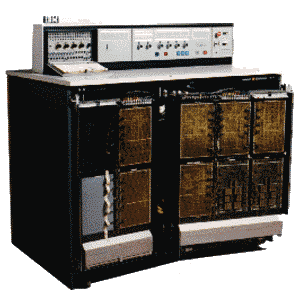
![]() April
7, IBM announces the first 'Family' of computers: the IBM
/360, after 5 years of development. The machine will start shipping in 1965
April
7, IBM announces the first 'Family' of computers: the IBM
/360, after 5 years of development. The machine will start shipping in 1965
It is the first in the 3-rd generation of computers. This series consists of six with each other compatible computers and peripherals. Their controlling circuitry is stored on chips. This is a new strategy to make computers compatible with each other.
In the same time computers from different manufacturers still could not "talk" to each other. Even at the level of plugs. Later the term "plug compatibility" will be used when manufacturers want to sell a machine to a client that has a computer from another manufacturer.
Knowing that it will be no surprise that this new IBM "computer family" is a runner. Up to a 1000 machines are sold every month!(20)
IBM also introduces the 1403 printer for System/360. It uses a revolving metal chain (hence chain printer), and can print 1100 lines of text per minute.(25)
However the operating system to run on this machines is riddled with bugs, it hangs up machines without apparent cause. This threathens the existence of IBM.
![]() Online transaction processing
made its debut in IBM´s SABRE reservation system, set up for American
Airlines. Using telephone lines, SABRE linked 2,000 terminals in 65 cities to
a pair of IBM 7090 computers, delivering data on any flight in less than three
seconds.
Online transaction processing
made its debut in IBM´s SABRE reservation system, set up for American
Airlines. Using telephone lines, SABRE linked 2,000 terminals in 65 cities to
a pair of IBM 7090 computers, delivering data on any flight in less than three
seconds.
![]()
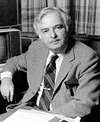 BASIC
- Beginners All Purpose Instruction Code - is introduced as a computer language
by professors Thomas Kurtz en John Kemeny (picture left). They got lots of help
from undergraduates. And BASIC would become the "lingua franca" of
the young computer community. (20)
BASIC
- Beginners All Purpose Instruction Code - is introduced as a computer language
by professors Thomas Kurtz en John Kemeny (picture left). They got lots of help
from undergraduates. And BASIC would become the "lingua franca" of
the young computer community. (20)
One of the main goals of this language is to train students in programming computers with a relatively simple language
In the Fall of 1964, the Dartmouth Time Sharing System became operational with BASIC as primary language for student program development.
The first BASIC was a slow, unstructured, interpreted language.(25)
![]() At a meeting of structural research
managers from the NASA centers Tom Butles proposed that NASA develop a general
purpose computer program using the new Finite Element method.(25)
At a meeting of structural research
managers from the NASA centers Tom Butles proposed that NASA develop a general
purpose computer program using the new Finite Element method.(25)
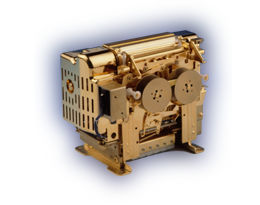
![]() Epson
invents the dot matrix printer: EP-101(27). The machine is
developed beause the mother company Seiko needed a small device to be used with
the time keeping instruments at the Olympics in Tokyo. It will take another
four years before this printer will go into serial production.
Epson
invents the dot matrix printer: EP-101(27). The machine is
developed beause the mother company Seiko needed a small device to be used with
the time keeping instruments at the Olympics in Tokyo. It will take another
four years before this printer will go into serial production.
![]() Computer Aided Design (CAD)
is developed through a mutual project by IBM and General Motors.
Computer Aided Design (CAD)
is developed through a mutual project by IBM and General Motors.
![]() First Local Area Network is
developed at Rank Xerox's Palo Alto Research Center
First Local Area Network is
developed at Rank Xerox's Palo Alto Research Center
![]()
| Last Updated on July 23, 2004 | For suggestions please mail the editors |
Footnotes & References
| 20 | IEEE The Computer Society |
| 21 | www.hursley.ibm.com/forty/ibm1961.html |
| 22 | www.ibm.hursley.com |
| 23 | The original source code (which ran on 4k of memory!) can still be found at www.media.mit.edu/groups/el/projects/spacewar/sources or ftp://ftp.digital.com/pub/DEC/sim/sources/sim_2.3d.tar.Z There's also a copy of the PDP-1 manual at www.dbit.com/~greeng3/pdp1/pdp1.html |
| 24 | TERRENCE MASSON, www.visualfx.com |
| 25 | Marian Bozdoc, Auckland NZ, www.bozdoc.f2s.com |
| 26 | www.computable.nl |
| 27 | this picture is slightly edited for clarity |
| 28 | The name EPSON is derived from son of EP (electronic printer), picture from www.epson.de |